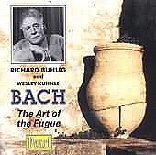Richard Buhlig (1880-1952) was an American-born pupil of Theodor Leschetizky who eventually settled into a teaching career in Southern California that was marked by occasional local performances. His musical interests veered toward intellectually challenging works and new music (the young John Cage, in fact, studied with Buhlig) rather than Romantic virtuoso staples. While Buhlig did not record commercially, he made private recordings of Beethoven’s Hammerklavier and Op. 109 sonatas, plus Bach’s Chromatic Fantasy and Fugue and a Prelude and Fugue from the Well-Tempered Clavier (all reissued on Dante HPC 015, now out of print). These date from around the mid-1930s, as does this private recording containing Buhlig’s two-piano arrangement of Bach’s The Art of Fugue, with Buhlig’s pupil, California pianist Wesley Kuhnle, at the second keyboard. It’s a relatively unadorned transcription for the most part, fortified by discreet octave doublings during long, sustained notes and at climactic points.
Pieces that normally push a solo pianist’s skills to their limits, such as the Sixth, Seventh, Ninth, and Eleventh Contrapuncti and the mirror fugues in four voices, benefit from the textural clarity and faster tempos more easily obtained with a second pair of hands. The performance is much like the arrangement itself: clean, sober, straightforward, perhaps a bit staid and uninvolved at times, and utterly different from the unbridled, rough-hewn passion we hear in Buhlig’s solo recordings. While the sound is rather dry and dynamically constricted, the two pianos come across clearly and well balanced. Donald Manildi’s excellent and informative annotations also must be mentioned. Although essentially a curio, it’s one that hardcore collectors of historic piano recordings might wish to investigate.
































